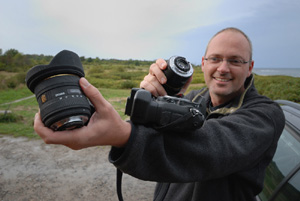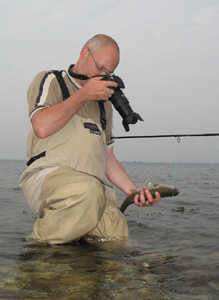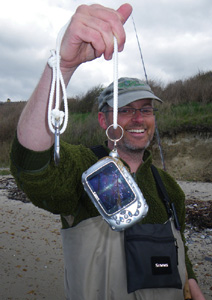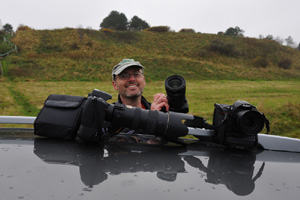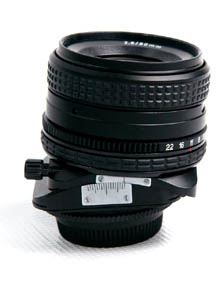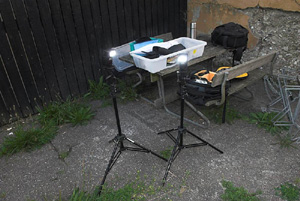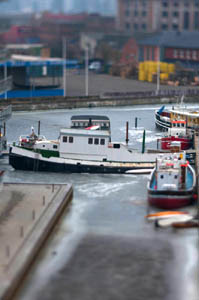What's in my bag
I see these articles and videos all over the web, and like them. Despite claiming the opposite, we're obsessed with gear, aren't we? Here is my gear list.
I'm a Nikon shooter. I turned to Nikon from Minolta some years ago. Before that I had shot Minolta since my first ever camera—for more than 30 years actually. And I had been happy with Minolta, but after the Konica merger and then the the Sony takeover, I grew tired of the uncertain future and lack of third party gear, and decided to get what my best friends had: Nikon.
Below I'll list the stuff that I use regularly. It's not all in my bag of course. I actually go without a bag most of the time, oftentimes just bringing a body mounted with just one selected lens.
On longer trips I usually pack a bag for the purpose, and for my lighting gear, stands, reflectors etc., I have a large, flat plastic box that I have permanently packed with my strobist gear.
Bodies
I currently have three bodies, all DX-format. I have “standardized” on DX, and gotten to very good terms with crop factors and whatnot, and contrary to what many full frame shooters think, shooting DX is not a stage on the way to FX. I for one am no FX wannabee. I'll stick to DX as it is. My lineup consists of:D300s w/grip: I acquired this latest DX-body as a replacement for the D200, and it's doing a great job as my main body. Great IQ, great controls, great display. A real performer.
D5100: I acquired this body primarily to do video, and have already done some and loved it. But I use the D5100 for stills quite a lot, not least thanks to the articulated screen, which makes it a very good camera to use on a tripod.
D200 w/grip: This was my first ever Nikon body, and is still ticking along with some 30,000 clicks in its belly. I often use it as a “compact” camera without the grip.
D40: I bought this used as a backup before a vacation, and just love that little gem! Light, easy to use and with an amazing image quality in its 6 megapixels.
Fuji X100: This is definitely my new camera love! I have shot a ton of images with it since I got it, and use it way more than any of my SLR's. It's simply a perfect camera to carry and it takes some great pictures.
Canon Powershot D10: This hardly qualifies as a body, but I always carry a compact camera, and the Canon Powershots have been my favorites for a long time. This is shock- and waterproof, which makes it perfect for me.
Lenses
Oh, man! Where to start? Even though I'm no Bjørn Rørslett, I have collected quite a few lenses already, and ever so often I feel the urge for more, so I expect the collection to grow. I like good glass, and consider it the best investment you can make as a photographer. Pro grade zooms and bright primes is my weakness. And oddball lenses too. I like having fun.Listed shortest focal length first:
Nikon 10.5mm f/2.8 fisheye: A fun lens that takes some great images. Not used too often, but nice to have for the effect and very wide angle.
Sigma 10-20mm f/3.5-4.5: My go-to wideangle zoom. A really, really great lens on a DX-body. Severely beat up at this time, but still working as it should.
Nikon 17-55mm f/2.8: The workhorse. A stunningly good lens and a real all round piece of glass.
Sigma 20mm f/1.8: My newly found lens love. Wide enough to be fun and bright too, delivering an excellent image quality.
Sigma 30mm f/1.4: Much like a 50mm on full frame. A classical focal length, and f/1.4 and an impeccable image quality doesn't make it worse!
Nikon 35mm f/1.8G: A no brainer as I have said. Probably the most lens you can get for your money in the DX-lineup.
Nikon 40mm f/2.8 macro: Another one of those gotta-have lenses, which are so inexpensive and useful that it makes no sense not to buy it. An excellent macro with great magnification, but a lot less working distance than the 85mm macro mentioned below.
Nikon 45mm f/2.8 AI-P: A so called pancake lens and for a good reason. It's flat! Extremely compact, excellent build and image quality and manual focus. I always wanted one and found one used at a good price. It does nothing that I haven't got a lens that does already, but it's so darn cute!
Sigma 50mm f/1.4: A beast of a lens! Large, bright, sharp and able to produce some fantastic pictures. Great for portraits on DX.
Nikon 70-200mm f/2.8 VRII: It's almost needless to write about this one. Probably only surpassed by its newer replacement.
Nikon 85mm f/1.8D: I bought it used, and even though it's slightly longer on DX it's still perfect for portraits and a marvelous lens for very little money.
Nikon 85mm f/3.5 macro: The latest lens in my collection, and already a favorite. I'd love a little more brightness, but the 1:1 macro range and focal length makes it a very useful lens for my macro work.
Nikon TC 1.4: A classy teleconverter that does wonders on the 70-200.
As you'll notice, I have no kit lenses or wide range zoom lenses. I have shot with Nikon plastic kit lenses, the 18-55mm f/3.5-5.6, the 18-70mmf/3.5-4.5 as well as Nikon's famous 18-200 and Tokina's not quite as famous 18-270mm. None of these ever convinced me that kit lenses or do-it-all lenses are my cuppa. Some people love them. I don't.
Oddball lenses
Apart from the Nikon fisheye already mentioned above, I have also managed to get my hands on these:LensBaby 3G (Muse): My first venture into the oddball lenses scene. Not easy to master, but a lot of fun! And inexpensive too.
LensBaby Composer w/single, double, plastic and pinhole optics: Odd lenses put into a very functional system. Much easier to control than the 3G and with a wealth of possibilities.
Arax/Photex tilt/shift 80mm f/2.8: A newly acquired lens and about the least expensive way you can get started on T/S. It's a fully manual lens, built like a tank, and good enough to get me going, albeit far from Nikon's own extremely expensive offerings.
Holga plastic: Plastic indeed. 38 grams of miserable quality, mechanical as well as optical.
Skink Pinhole: Another oddball lens, but a very good quality one. Made in Germany and with several options including a pinhole, a zone plate, a zone sieve and more. Very well made and able to take some eerie pictures.
Light
I have always loved working with flashes, and did off camera flash work even back when the flash was always attached to the camera with a wire.2 x Nikon SB800: The old workhorse in the Nikon program. You can get very far with two of these babies. I sometimes borrow two more from a friend. Flashapalooza!
2 x Godox Propac PB820 external battery packs for the flashes. I was tired of charging small batteries, and these pack have juice for many, many shots at full power.
Orbis ringflash adapter: I love the ringflash look, and the Orbis delivers. I also use it for quite a bit of macro work.
Roundflash ringflash adapter: A newcomer. A collapsible softbox/ringflash from Poland. Large yet lightweight and not least compact when packed.
Interfit stands, umbrellas, Manfrotto brackets: For off camera work stands and softeners are a must. Have a small collection now.
Flash Waves wireless triggers: Sure I'd love to have Pocket Wizards or Radiopoppers, but my Korean Flash Waves have done a fine job whenever I have needed them.
Interfit reflectors: Bought a flip-out combo model with diffuser, black, gold, silver and whatnot. Nice kit, very handy and inexpensive too.
Other stuff
I tote around quite a lot of other things inside my bag as well as outside. The most used first:Manfrotto 055B tripod: a sturdy and flexible tripod.
Markins M10-Q ballhead: Solid as a rock and still silky smooth.
Gitzo Explorer carbon tripod: a little akward in its mechanics, but light and stable.
Acratech Ultimate ballhead: neat and lightweight and very stable.
Giottos VH6011-658D Mini Video Head: A nice, lightweight but still sturdy dampened video head that I bought to use with the Nikon D5100. Great value for money.
Lots of Arca-Swiss brackets: This is the system that enables me to snap gear on and off the tripods quickly.
Manfrotto Magic Arm and Flex Arm w/Super Clamps: Arms that can clamp onto tube, edges, tripods, stands and much more. Can hold lamps, flashes, reflectors and even cameras.
Seagull angle finder: I could buy an Original Nikon, but this one works fine.
Strobies wireless release: I used to have a cheap Chinese gizmo, but this is nicer and much more stable.
The bag
I only have one bag that I use regularly:Kata R-103: I got this bag a few years ago, and haven't looked further. I have had LowePro , Crumpler and other brands, which are all fine bags, but the Kata is my stopping point for now. Amazingly spacious and still very comfortable. It has a gazillion add-ons and flexible solutions, but I have stripped it down and use it as plain as possible all the time.
I loved the Crumplers for style and for their whole company philosophy, but I have to say that the Kata might be more boring, but it's a better bag than my Farmer's Double ever was and way, way better than the LowePro Mini Trekker that now holds my old Minolta gear.
